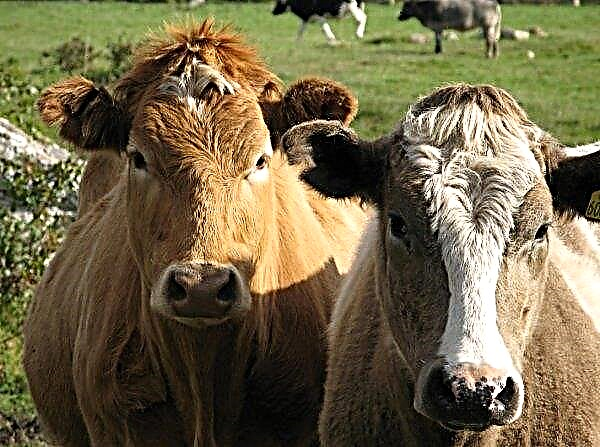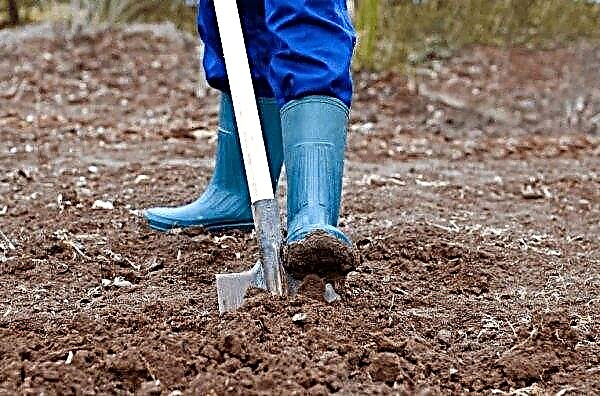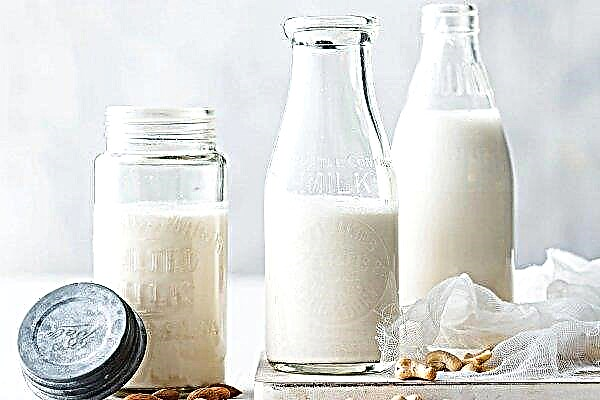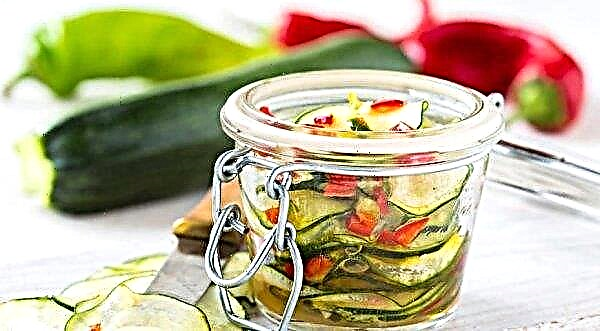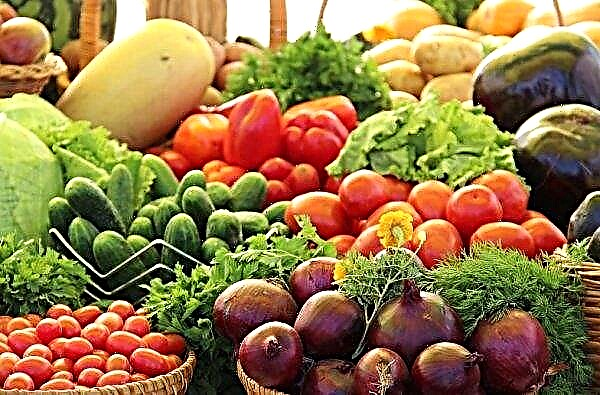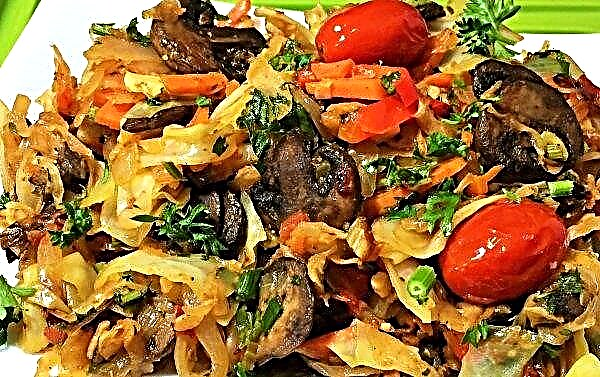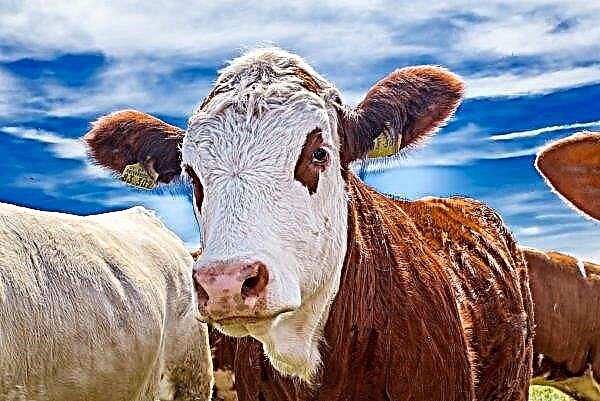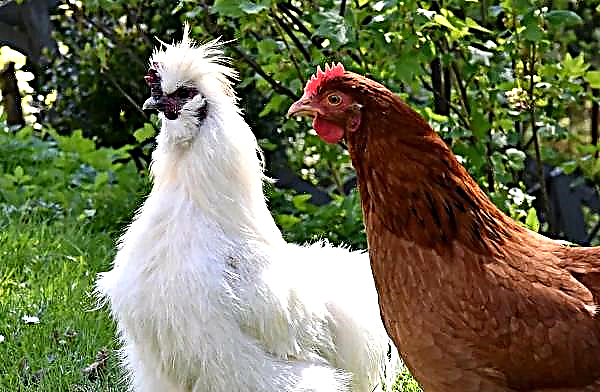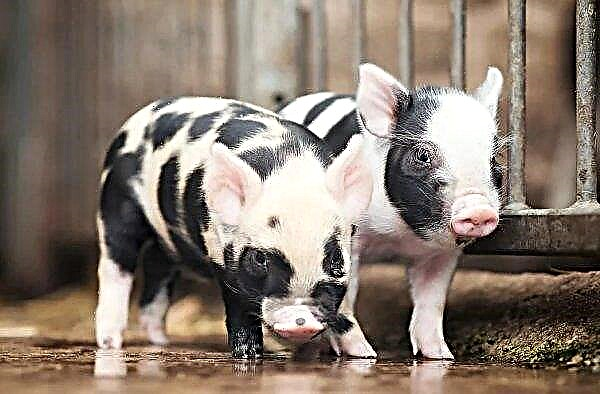Geese are one of the most popular types of poultry that are kept for the purpose of obtaining dietary, tasty and healthy meat. Subject to the basic rules of growing and feeding geese, it is possible to get a good high-quality livestock in a fairly short time. How to properly provide waterfowl nutrition and what are the differences in their diet in winter and summer, let's figure it out.
Types of feed for geese
To increase the productivity of domestic geese, as well as to achieve intensive weight gain allows you to properly balanced vitamin and mineral diet. There are three main types of feed, each of which is used under certain conditions for keeping birds.

Wet
Wet foods are various types of mixers or chatterboxes, which include grain mixtures, boiled vegetables, dairy products, oilcake, vegetable waste, etc. In most cases, the basis of wet nutrition is combined feed.
When using mash ups, a few simple rules should be followed:
- correctly calculate the portion for one feeding and prevent the presence of residues, as the feed spoils very quickly;
- wet food should be supplemented with dry mixes;
- the mash should have a certain consistency. Geese should not be given too viscous feed.

Typically, this type of food is provided to birds three times a day: in the morning, at lunch, and late in the evening.
Dry
Dry feeds are one of the simplest, cheapest and most convenient types of nutrition. They are already completely ready for use. Most often, the basis of dry food is: crushed and ground grain - barley, oats, millet, wheat, as well as animal feed and corn. Despite the fact that this type of feed is simple and convenient to use, they have a significant drawback - low nutritional value. Using only dry food, the bird is poorly gaining weight, growing and developing at a slow pace. It is practiced only in an unproductive period of time.

Combined
The symbiosis of dry and wet food is a combined diet. This type of feeding is considered the most optimal for the bird, because it allows it to gain weight and dynamically develop. In addition, geese eat it with great pleasure.
Important! To feed the birds and get excellent weight gain, they need to organize a diet that includes all three types of feed.
Basic feeding rules
Proper development of the diet makes it possible to provide geese with all the required valuable components, vitamins and minerals, as well as to achieve a quick increase in fat and muscle mass.

When feeding birds for slaughter, it is recommended to adhere to the basic rules:
- give food at about the same time;
- adult geese are advised to feed no more than four times a day;
- when feeding wet talkers, you need to correctly calculate the portion so that there is no residue;
- mixers in the cold season must be prepared on the basis of a warm liquid;
- the poultry diet at any time of the year should be enriched with an additional portion of minerals - calcium, sodium and phosphorus, which are required to maintain good, good health of waterfowl;
- in summer, waterfowl who are on pasture paddocks are recommended to feed only in the evening;
- houses should be equipped with clean drinking bowls, which should always be accessible;
- in winter, the menu should be enriched with feed with a high content of vitamins A, E and D;
- in warm time, birds need to be provided with a large amount of greenery - approximately 2 kg of greenery per day per individual;
- 30 days before slaughter, the diet of waterfowl is advised to be strengthened by adding cereals and foods with a high protein content. Eating corn is reduced at this time, because it can cause excessive obesity.
Did you know? To get the most valuable delicacy - foie gras (goose liver), birds are force fed by passing the feed through a hose located in the throat. However, in some countries such food is prohibited by law, as it is considered from the point of view of cruelty to animals.
How and how to feed geese for quick growth for meat
It’s easy to ensure a balanced diet for geese. So that they intensively gained weight, several types of fattening are used.
Video: Feeding the geese for quick growth
Meadow feeding
The most economical option for feeding is meadow, in which birds graze almost round knocks. For grazing, it is recommended to select places where various types of herbs grow: legumes, alfalfa, clover, oats, rye, timothy, wheatgrass, etc. Birds prefer to eat juicy and young greens, which allows you to saturate the body with microelements that contribute to good productivity and reproduction.
An ideal option would be the presence of small reservoirs near the pasture, where geese will be able to supplement the daily diet with small fish and algae. In the evening, it is recommended to diversify the menu with grain mixtures, corn, grass flour, root crops.Important! It is not recommended to graze geese in glades where sedge, cuffs or “crow's feet” grow, since these herbs have a specific bitter taste and can discourage waterfowl from eating green.
Intensive fattening
When growing geese solely for the purpose of obtaining meat, it is necessary for them to provide enhanced intensive fattening, which is based on a reduction in the motor activity of the bird and keeping it in a special cage or box. A specially developed diet and cell growth allow you to build muscle and fat mass in a short time, and achieve a good weight gain.

For proper intensive feeding, flour is used, which contains cereals in the following proportions:
- oatmeal - 25%;
- corn - 20%;
- barley - 20%;
- wheat bran - 19%;
- wheat - 15%;
- salt - 1.5 g.
Did you know? Domestication of geese occurred more than 4000 years ago in ancient Egypt. The progenitor of the modern bird was the wild northern goose.
Pre-slaughter feeding
Of course, a few days before slaughter, food and care for waterfowl should be of the highest quality. 14 days before the expected slaughter date, geese are transferred to 4-6 meals a day, with the main emphasis on the use of steamed grain. Any type of grain is used, except for rye, which negatively affects the nutritional qualities of goose fat.

In addition, the main part of the menu of waterfowl at this time should be: feed made from flour, the nutritional qualities of which will contribute to building up a large percentage of meat with a small amount of fat. Also, before slaughter, geese walks are reduced, and they are placed in special cages or boxes that maximize their motor activity.
In the process of fattening before slaughter, the basis of the diet, about 65%, should include: boiled potatoes, bagasse and flour.
Important! Regardless of the feeding method, geese should always have access to water. Otherwise, various problems associated with the digestive tract may develop. In addition, through the water of the bird, the nostrils are rinsed from the remains of the feed.
Feeding Features
The main menu of geese also depends on the season.
In winter
Due to the lack of grazing feeding in the cold period, geese require more enhanced nutrition than in summer. In winter, the number of feedings from two must be increased to four, while an approximate diet is developed in this way:
- morning and lunch consists of wet food, which includes: boiled potatoes, raw carrots or sugar beets, grass flour and animal feed;
- the second lunch and dinner involve the use of soaked grain mixtures: barley, oats, ground millet, crushed wheat, bran.

The menu is also enriched with a silo of clover, cabbage, legumes, which almost completely replaces fresh greens for birds. Strengthen the immune system of geese, increase the body's resistance to various diseases, in particular, colds, helps needles of spruce or pine, rich in vitamin C.
To enhance the palatability of the feed and its nutritional value, they make yeast: 20 g of yeast are diluted in 2 l of warm water, 1 kg of grain is added and insisted for several hours at a temperature of + 20 ° С.In summer
As a rule, geese are cultivated in the period from March to August, when there is the possibility of pasture walking. For almost the entire season, waterfowl spend time in the meadows, which, in turn, allows breeders to significantly save on feed and, thus, increase the profitability of maintenance.
It should be noted that in choosing herbs for feeding, geese are very picky. They like to eat legumes, clover, alfalfa, wheatgrass, various cereals before flowering. Birds produce algae, small fish, reeds, etc. from fresh water. Fresh greens during the warm period make it possible for geese to fill the body with valuable components, to accumulate a certain amount of fat, which will easily survive the cold.

In the evening, birds are fed with other types of feed: grain, corn, root crops, vegetables, flour. Be sure to supplement the menu with components designed to improve digestion: sand from the river, fine gravel, shells.
Signs of improper feeding
The diet and its quality, of course, affect the behavior of birds, their health and appearance. The following symptoms may indicate that there are errors in feeding waterfowl:
- diarrhea, digestive problems: may occur due to an overabundance in the green feed menu. In such cases, it is recommended to temporarily transfer the bird to feed in the form of granules;
- coughing and sneezing frequently: are a sign of excess dry or fine food, which makes breathing difficult and causes a dry cough. When such problems arise, the volumes of wet mash moths increase for birds, shells or fine sand are added to the menu. If the correction of nutrition did not give the desired results, then to clean the esophagus, geese are forced to pour a certain amount of water into the throat;
- diarrhea, accompanied by apathy, loss of appetite, poor health: this condition indicates intoxication of the body. Most likely, the bird ate during the walking poisoned grass. Usually, adults are well versed in meadow grasses, but young animals, by their inexperience, can taste forbidden greens. In case of poisoning by waterfowl, gastric lavage is carried out by pouring a large amount of water into the throat;
- digestive upset: in most cases, it may occur due to a sharp transition from concentrated nutrition to green fodder. In this option, you need to adjust the power;
- poor appetite, loss of plumage: indicate a deficiency in the diet of micro and macro elements, as well as biologically active substances. To replenish them, the menu should be enriched with vitamin-mineral complexes.
Did you know? Geese are long-lived birds. In the wild, their lifespan is about 25 years. At home, they are able to live for about 30 years.

Proper organization of food for domestic geese makes the cultivation of this type of bird very simple and cost-effective. Breeders, having drawn up the correct feeding schedule, have the opportunity in a short time to grow a large population that will produce dietary meat with an extreme taste and high nutritional value.

